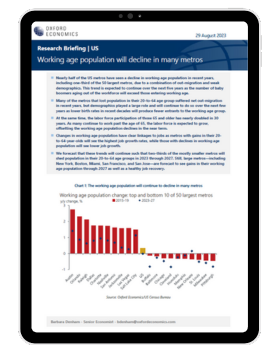Working age population will decline in many US metros

Nearly half of the US metros have seen a decline in working age population in recent years, including one-third of the 50 largest metros, due to a combination of out-migration and weak demographics. This trend is expected to continue over the next five years as the number of baby boomers aging out of the workforce will exceed those entering working age.
What you will learn:
- Many of the metros that lost population in their 20-to-64 age group suffered net out-migration in recent years, but demographics played a large role and will continue to do so over the next few years as lower birth rates in recent decades will produce fewer entrants to the working age group.
- At the same time, the labor force participation of those 65 and older has nearly doubled in 30 years. As many continue to work past the age of 65, the labor force is expected to grow, offsetting the working age population declines in the near term.
- Changes in working age population have clear linkages to jobs as metros with gains in their 20-to-64-year-olds will see the highest job growth rates, while those with declines in working age population will see lower job growth.
Tags:
Related Services

Service
US States and Metro Service
Forecasts, scenarios and analysis for US states, metropolitan statistical areas and counties.
Find Out More
Service
Global Cities Service
Make decisions about market and investment strategies with historical data and forecasts for 900 of the world’s most important cities.
Find Out More
Service
City Scenarios Service
Assess the impact of risk scenarios on cities and regions Our service provides a baseline forecast and three alternative scenarios for a broad range of economic and demographic indicators for each location.
Find Out More